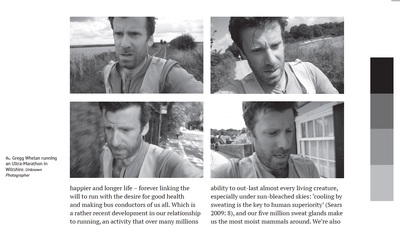Whelan, Gregg  ORCID: https://orcid.org/0000-0001-5434-5985
(2012)
Running Through A Field: Performance and Humanness.
Performance Research: A Journal of the Performing Arts, 17 (2).
ISSN 1352-8165
ORCID: https://orcid.org/0000-0001-5434-5985
(2012)
Running Through A Field: Performance and Humanness.
Performance Research: A Journal of the Performing Arts, 17 (2).
ISSN 1352-8165
![[thumbnail of Running Through A Field]](https://falmouth-test.eprints-hosting.org/781/1.hassmallThumbnailVersion/Running%20Through%20A%20Field.jpg)  Preview |
Image (Running Through A Field)
Running Through A Field.jpg Download (223kB) | Preview |
Abstract / Summary
Endurance running hypothesis asks a fundamental question of performance practice, because it asks us to reconsider the very nature of the human body. In evolutionary terms running produces humanness, it is the body’s first performance. Long before arts disciplines and practices, there was running – the act accomplished by human bodies which produced human culture. There are many readings of performance practice that put the body center stage, and that see the field as a body-based enquiry into a number of cultural phenomena. Admittedly, this is a broad definition for a broad practice but it perhaps does passing justice to the field’s interest in bodies doing something in front of, or with, other bodies. So how does the body-based discipline of contemporary performance practice react when the body has been rediscovered and reimagined as one defined by running and endurance? The question, as I see it, is not whether running can be discussed in terms of being ‘art’ (of course it can) but rather what are the possibilities of using endurance running as a mode and site of performance-based research? The dancing body, a cultural phenomena that has engendered multiple modes of enquiry – training, the rigours of ‘technique’, discursive mappings of its social and political agency, etc., – is a known site of performance research: the running body is unknown. Imagine if our only experience of dance was as a mode of exercise, and if Zumba, the current fitness craze, was our only practiced choreography – this is generally where we are with running. As Benjamin Cheever has it: ‘Running is like breathing, men and women have always done it… And like breathing, running is not always noticed’ (Cheever 2007: 236). So, how to notice running? How to engage with a difficult practice?
| Item Type: | Article |
|---|---|
| ISSN: | 1352-8165 |
| Subjects: | Performance > Theatre > Acting Performance > Dance Performance > Theatre |
| Courses by Department: | Academy of Music & Theatre Arts > Dance |
| Depositing User: | Gregg Whelan |
| Date Deposited: | 27 Nov 2014 10:10 |
| Last Modified: | 23 Nov 2023 13:15 |
| URI: | https://falmouth-test.eprints-hosting.org/id/eprint/781 |
Actions
 |
View Item (login required) |

 Advanced Search
Advanced Search Tools
Tools Tools
Tools